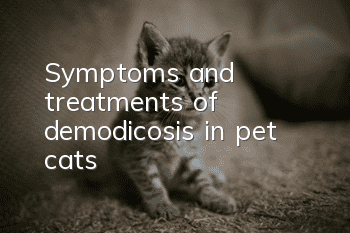Symptoms and treatments of demodicosis in pet cats

Feline Demodex is very similar to canine Demodex, with only minor taxonomic differences. Eggs are slender or oval in shape rather than spindle-shaped. All immature stages of Demodex feline are more slender than those of Demodex canis.
Feline demodicosis caused by Demodex felis is very rare. Localized demodicosis lesions occur in the eyelids and around the eyes, head and neck. The degree of itching varies. Symptoms include erythema, dandruff, crusting, and hair loss. Localized demodicosis in cats is usually self-limiting. Examination of local demodicosis in cats only shows ceruminous otitis externa.
Feline systemic demodicosis is rare, but is often less severe than the canine form. Purebred cats are susceptible. It usually starts in the head and neck and may later spread to the trunk and extremities. Lesions include erythema, scaling, crusting, hyperpigmentation, and alopecia areata or plaques. The degree of itching varies. Feline systemic demodicosis often has underlying causes, such as feline leukemia virus or feline immunodeficiency virus infection, diabetes, systemic lupus erythematosus, adrenal hyperactivity, and neoplastic disease. Of course, feline demodicosis can also be idiopathic.
Treatment methods for pet cat demodicosis:
Soaking in lime sulfur mixture or benzamidine. The concentration of amitrazine is 125ppm or 250ppm, once a week. Some cases of generalized demodicosis in cats are easier to treat than the canine type, possibly because the parasitic site of demodicosis in cats is more superficial than in dogs. Lime sulfur and a mild ear canal insecticide can be tried to treat Demodex in the ear canal.
- Will Ragdoll cats’ fur become darker in winter?
- What kind of special litter box should be prepared for pet cats?
- Why do cats eat dead leaves?
- Is it good to neuter male cats?
- Is it okay for cats to eat one kind of cat food for a long time?
- Will impure folded-eared cats get sick?
- Do cats cry after being abandoned?
- Symptoms and treatments for spontaneous cystitis in cats
- Can hair in a cat's eye come out on its own?
- How to change a timid cat?



